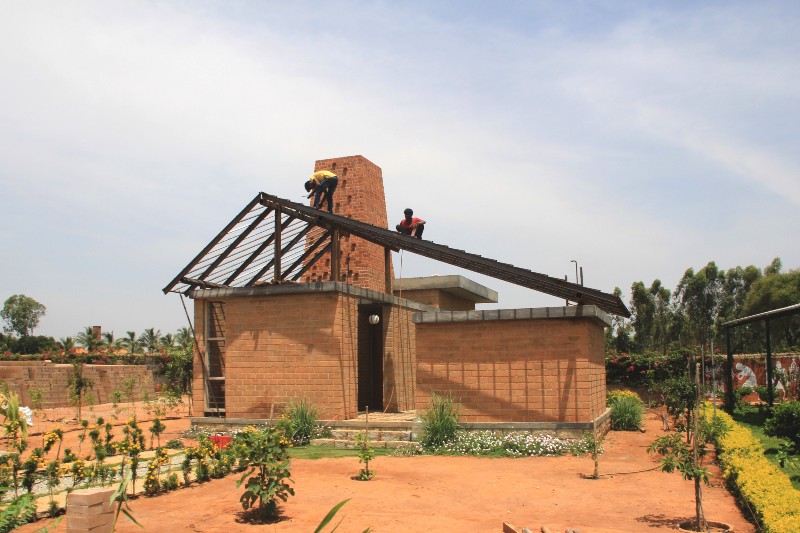Building For A Sustainable Future Using Natural Solutions

Is it possible to build on a landscape, take away from it, and yet be able to leave it more beautiful than it was originally? These are the thoughts in my head as my hands, coated with cool, wet earth caress the walls of a cafe while with a slow sway, my body joins in. This is seriously therapeutic business.
I’m here to meet the team from Made in Earth, a sustainable architecture practice in Bangalore that’s opened up its workspace for the day and invited patrons and passersby to participate in plastering the interior walls of a restaurant. The young quartet of architects and engineers are also doubling up as masons, taking time off from plastering alongside visitors to talk passionately about building cities of the future by going back to the earth.
Co-founded by Shruthi Ramakrishna and Jérémie Gaudin in 2014, Made in Earth advocates the use of materials and processes that are available everywhere and are minimally impactful to the environment, to people involved in the construction and to those who will eventually use the building. This is ensured with the use of locally sourced materials like earth, lime, straw, bamboo, wood, and rice husk that are combined in a variety of techniques involving minimal processing. There is also a committed effort to bridge the gap between the design and execution processes and the team regularly dives into the construction themselves, something that has strongly influenced their core values and work.
A tadelakt wall at a cafe in Mysore (left) and natural plaster on a restaurant wall in Bangalore
Honouring lives and landscapes
The energy required to make 1 bag of cement is equivalent to the energy required to drive your car 350 kilometres, a fact Gaudin likes to share, and a typical house uses 500–800 bags of cement!
Alternatively, earth is an energy-efficient, abundantly available resource that greatly impacts the comfort and usability of the building. Many of the products we use in our daily lives contain chemical paints, polish, varnish, glue that emit volatile organic compounds (VOCs) all their lives. Human activity releases CO2 and humidity that become trapped in our walls, impacting our health and the environment.
Natural plasters and clay paints are safe and VOC free. They are natural regulators of temperature, humidity, and air quality, expelling the CO2, odours, moisture, and VOCs emitted by other materials in our homes. A flexible raw material, earth requires almost no processing to make it useable. The Made in Earth team approaches every project in its context, choosing material that is most easily and abundantly available on or around the site and with the lowest possible carbon footprint.
Ramakrishna highlights the human impact of earth construction as well as its benefits to the local economy. Working with local labour and raw materials provides employment, reduces the monetary and environmental costs of sourcing inputs from outside, and keeps alive traditional skills like lime plastering that exist in unique forms around India but are slowly disappearing. Natural materials are also much safer and healthier for the people involved in constructing the building. Further, earth architecture employs labour intensive techniques that redistribute the economics in different ways than does conventional construction where the ratio of material to labour cost is usually 70:30.
Members of the Made in Earth team on site
As accessible as earth
Earth has been used in ancient sites around the world — in Morocco, Iran, Yemen, China, and Mexico indicating that it has been around for centuries as one of the oldest building materials that has adapted to various environmental conditions. One is noticing a resurgence of it around the world but in India, all its benefits notwithstanding, earth architecture is mostly visible in suburban farmhouses, traditional rural homes or off-grid earthship resorts, all of which has limited the thinking around its use in urban settings. But, earth lends itself to be shaped in a variety of ways, uniting harmoniously with other materials, including concrete and steel, thereby making it a material that can be used anywhere.
The phrase ‘Sustainable architecture and building practices for all’ prefaces Made in Earth’s approach to its work and the team is focussed on continuously innovating its practice to include different building materials and adapt their design to make ecological architecture relevant and appealing to a wide range of use cases and contemporary sensibilities. “To make it aspirational, we’re trying to arrive at more scalable techniques without compromising on aesthetics, all at a cost comparable to that of conventional construction”, Gaudin adds. They’re experimenting with large scale public projects and quick finishes and are showing that earth could be the material of the future.
“We don’t see too much use of earth in buildings today because people are uninformed of its existence, its benefits as a material and its adaptability to their settings”, informs Agnimitra Bachi, a core member of the MIE team. However, there has been a growing interest in earth architecture which the
team is addressing by making available ready-to-use natural plasters and paints that people can apply themselves. Ramakrishna explains, “One of the easiest ways of bringing earth architecture into urban homes is by using natural plasters and paints on our interior walls which make up an average of 50 percent of the surface area of our interiors, making the whole space healthy and eco-friendly.” The plaster lends itself to infinite variations of look and texture and can be easily touched up.
The team strongly believes in the merits of participatory building projects as a means of educating people about earth architecture. They offer regular hands-on workshops on sustainable building techniques in educational institutions and urban spaces to share their knowledge with students, artisans, communities, and other architects and engineers.
Jérémie Gaudin demonstrates the application of a natural plaster
Growing awareness about climate change and active citizens’ movements around the country have been instrumental in the introduction of stricter norms around energy and water conservation in cities. But with ‘green construction’ being bandied about rather loosely today, it is up to the discerning citizen to be able to verify the claims of builders.
While it will be some time before earth architecture makes a dent in the mainstream market, Made in Earth believes the key to change is for people to be aware of the source of their raw materials and therefore their carbon footprint while building. And, choosing to build with earth, they chorus, is the easiest first step.
Maya is a social researcher by training. Her writing has appeared in Scroll, YourStory and The Alternative. She is the Founder of Eartha and tweets @Maya_Kilpadi.








